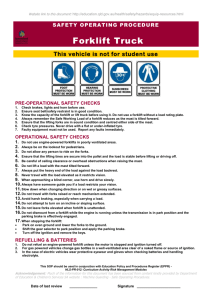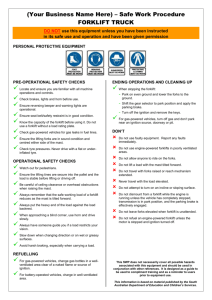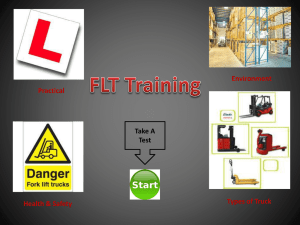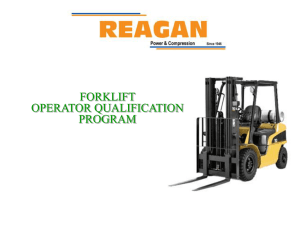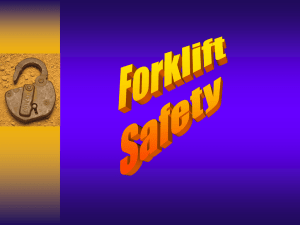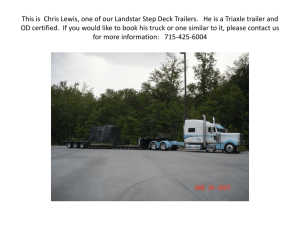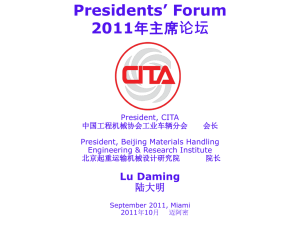Forklift Terms - Worldwide Forklifts
advertisement
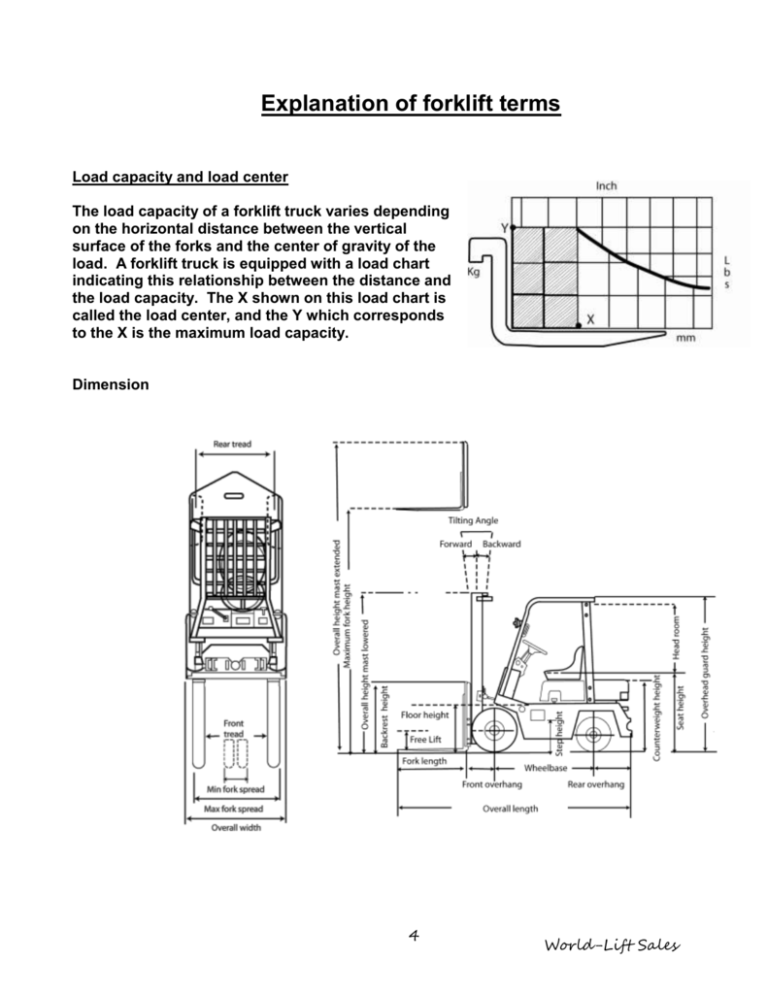
Explanation of forklift terms Load capacity and load center The load capacity of a forklift truck varies depending on the horizontal distance between the vertical surface of the forks and the center of gravity of the load. A forklift truck is equipped with a load chart indicating this relationship between the distance and the load capacity. The X shown on this load chart is called the load center, and the Y which corresponds to the X is the maximum load capacity. Dimension 4 World-Lift Sales Manual 2005 Maximum fork height The maximum fork height denotes the height from the ground to the upper surfaces of the forks when the forks are raised to their highest position with the mast positioned vertically. Free lift The free lift is the maximum lifting height of the forks with the mast position remaining unchanged. Overall length With forks: Without forks: The length from the front end of the forks to the rear end of the truck body. The overall length minus the length of the forks, i.e., the length from the vertical surface of the forks to the rear of the truck body. Overall width The maximum width of a forklift truck with the steering wheel set in the straight ahead position. Overall height The height to the top of the forklift truck. The mast overall height is classified in two categories: mast extended overall height when the forks are fully raised and mast lowered height the forks are fully lowered. The mast lowered overall height must be compared to the height of the overhead guard. This dimension is essential when judging whether or not a forklift truck will be able to pass through and entrance to a building or some structure. Wheelbase The horizontal distance between the centers of the front and the rear axle. Front overhang Distance from the front axle center to the vertical surface of the forks. Rear overhang Distance from rear axle center to rear of the truck body. Tread Distance between the center of the left and right tires on the same axle, or in dual-tire models, the distance between the centers of the left and right dual tires. 5 World-Lift Sales Manual 2005 Turning radius The radius of the locus drawn by the extreme outward side of the truck body when the forklift turns either right or left at the minimum forward speed with the steering wheel turned completely is called the “outside minimum turning radius”. The radius of the locus drawn by the inner front tire is called the “inside minimum turning radius”. Right angle (90°) stacking aisle The right angle stacking aisle denotes the minimum width of an aisle in which a forklift truck is able to load and unload after completing a 90 degree turn. Right angle (90°) intersecting aisle The minimum turning radius indicates the sharpness of a turn, but it does not indicate how large a space is required to make a turn. The right angle intersecting aisle is defined as the minimum width of aisle which intersects at right angles through which the forklift truck is able to pass. The catalog data is for a non-loaded with the forks set at their widest position. Fork length The length from the vertical surfaces of the forks to the front end of the forks. Floor height The height from the ground to the upper face of the floor board. Step height The height from the ground to the upper face of step. Seat height The height from the ground to the upper face of the seat when the operator [90 kg (199lbs)] is seated. 6 World-Lift Sales Manual 2005 Head clearance The head clearance from the under face of overhead guard to the upper face of seat when the operator [90 kg (199lbs)] is seated. Counterweight height The height from the ground to the top of the counterweight. Backrest height The height from upper of the forks to the top of backrest. Maximum fork spread The distance of outer forks when the forks are moved on the outsider notches of carriage. Minimum fork spread The distance of outer forks when the forks are move on the inside notches of carriage. Maximum ground clearance The height from the ground at the position where the clearance from the ground is considered minimum, except the elevating portion of the loading device and around the wheels. C1: C2: C3: under mast under power unit under frame Grade clearance The angle (α) between the plane contacting the front tires and passing the front lower end of the mast and ground is called the “Approach angle”. The angle (β) between the plane contacting the rear wheels and passing the rear lower end of the forklift truck and ground is called the “Departure angle”. The angle (γ) between the lane intersecting on the underside parts of the body where the first plane is tangent to the front tires and the second plane is tangent to the rear tires is called “Ramp brakeover angle”. 7 World-Lift Sales Manual 2005 These angles are essential for assessing the ability of a forklift truck to climb over an obstacle on the ground when traveling. Approach Angle Departure Angle Ramp break-over Angle Performance The performance of forklift truck is changed by road surface and oil temperature of the transmission or reduction gear etc. The value on this handbook shows on the concrete or asphalt road and oil temperature as below. Engine oil: Transmission: Torque converter: Reduction gear: Hydraulic tank: more than 50o C (122o F) more than 50o C (122o F) more than 80o C (176o F) more than 50o C (122o F) more than 40o C (104o F) Lifting/Lowering speed The speed of the forks as they move upwards and downwards is expressed both for their loaded state and unloaded state. The lowering speed has been limited (reduced) to prevent both vehicle instability and damage to the load which can result from sudden drops caused by the weight of the load. Travel speed The maximum truck speed when the accelerator pedal is fully opened. Drawbar pull The forklift truck is often used as a tractor for a trailer or other equipment. In such instances, the 8 World-Lift Sales Manual 2005 maximum traction varies according to the engine torque, reduction gear ratio, road surface and other factors. It also varies largely depending on whether or not the truck is loaded. Gradeability The “Gradeability” indicates the ability of the forklift to ascend a slope. This ability differs depending on whether it is loaded or not. The unit of measuring the Gradeability varies from manufacturer to manufacturer. The conversion table given below may be utilized for comparison purposes. The Gradeability of Tailift forklift trucks is normally expressed in tangent percent (tan 0%). Gradeability Conversion Table Degree (0) 1 2 3 4 5 6 7 8 9 10 11 12 13 14 15 16 17 18 19 20 21 22 23 Fraction (B/A) 1/57.2 1/28.6 1/19.1 1/14.3 1/11.4 1/9.5 1/8.1 1/7.1 1/6.3 1/5.7 1/5.1 1/4.7 1/4.3 1/4.0 1/3.7 1/3.5 1/3.3 1/3.1 1/2.9 1/2.7 1/2.6 1/2.5 1/2.4 tan 0% (B/A) 1.8 3.5 5.2 7.0 8.8 10.5 12.3 14.0 15.8 17.6 19.4 21.3 23.1 24.9 26.8 28.7 30.6 32.5 34.4 36.4 38.4 40.4 42.4 sin 0% (B/C) 1.8 3.5 5.2 7.0 8.7 10.5 12.2 13.9 15.6 17.4 19.1 20.8 22.5 24.1 25.8 27.5 29.2 30.9 32.5 34.2 35.8 37.4 39.0 Degree (0) 24 25 26 27 28 29 30 31 32 33 34 35 36 37 38 39 40 41 42 43 44 45 9 Fraction (B/A) 1/2.2 1/2.1 1/2.1 1/2.0 1/1.9 1/1.8 1/1.7 1/1.7 1/1.6 1/1.5 1/1.5 1/1.4 1/1.4 1/1.3 1/1.3 1/1.2 1/1.2 1/1.2 1/1.1 1/1.1 1/1.1 1/1.0 tan 0% (B/A) 44.5 46.6 48.8 51.0 53.2 55.4 57.7 60.0 62.5 64.9 67.4 70.0 72.7 75.4 78.1 81.0 83.9 86.9 90.0 93.3 96.6 100.0 sin 0% (B/C) 40.6 42.2 43.8 45.4 47.0 48.5 50.0 51.5 53.0 54.5 55.9 57.4 58.8 60.2 61.6 62.9 64.3 65.6 66.9 68.2 69.5 70.7 World-Lift Sales Manual 2005 Weight Truck weight: Total weight of a forklift truck without load. Gross truck weight: The truck weight plus the maximum load. In a forklift truck the gross truck weight also includes the weight of an operator. Weight distribution: The weight of a truck in both an unloaded and loaded state is distributed to the front wheels and rear wheels. 10 World-Lift Sales Manual 2005
